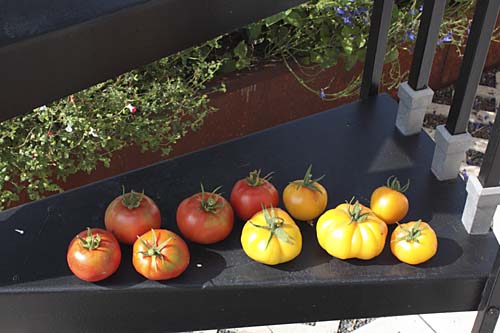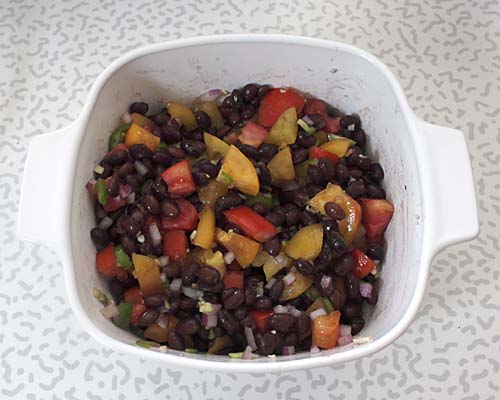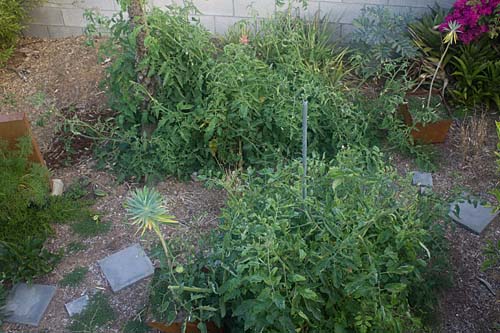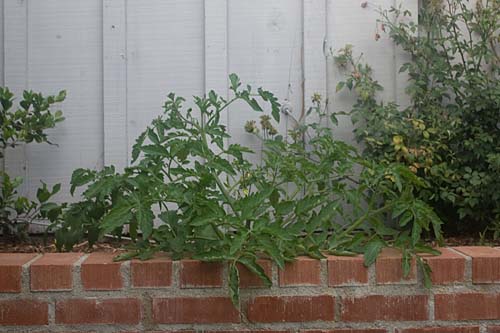Summer in my garden began officially on Wednesday, June 25 at approximately 6:35 p.m., when I held in my hands the first ripe tomato of the season. Here’s a shot of the fourth tomato, from yesterday. Seems like a couple of large two-legged mammals invaded the garden and ate the first three…
 I’ve said a couple unkind words against the mounstrously vigorous Mr. Stripey, but that’s the variety that bore first this year. The fruits so far have been small, about three ounces, sweet and extremely mild, with a very thin skin. The color is a rich, medium yellow, with dark rosy-red flushing to the fruits both inside and out. So far they don’t gush classic tomato flavor, but they’re still the best tomatoes I’ve had since last autumn’s farmer’s markets.
I’ve said a couple unkind words against the mounstrously vigorous Mr. Stripey, but that’s the variety that bore first this year. The fruits so far have been small, about three ounces, sweet and extremely mild, with a very thin skin. The color is a rich, medium yellow, with dark rosy-red flushing to the fruits both inside and out. So far they don’t gush classic tomato flavor, but they’re still the best tomatoes I’ve had since last autumn’s farmer’s markets.
The fact that this is the first variety to bear this year confuses me a bit. Mr. Stripey is usually listed as being a large, beefsteak, late-season tomato, bearing 80-85 days after being set out. Some sources mention that the variety often sold as Mr. Stripey is actually the smaller-fruited Tigerella, and several sites list their plants with both names. How unhelpful is that? If I can judge by photos of both varieties, mine looks much closer to the true Mr. Stripey, even though the fruit is small. What do you think?
| A couple Mr. Stripey images on the web: |
 |
 |
| [ source ] |
[ source ] |
| Versus a couple Tigerella images on the web: |
 |
 |
| [ source ] |
[ source ] |
Most sources list Tigerella as also being a late-bearing variety, so mistaken identity would have had little to do with my seeing the fruits towards the start of tomato season.
The thing that confuses me most about the identity of the tomatoes in the garden is the fact that Mr. Stripey sits about four feet away in the bed from the hybrid Early Girl. I planted the hybrid on the same day as Mr. Stripey, mainly to get some early tomatoes and to get a head start on summer. The Early Girl label says it should bear 50 days from being set out, and that’s been a reasonable estimate based on my past experience growing it. This season, even though Early Girl has a half dozen fairly nicely-sized fruits on its branches, they’re all still as green as the leaves. Fifty days from being set out? Not even close.
So, instead of concluding that Mr. Stripey came with the wrong label, I’m starting to wonder if I don’t have an impostor trying to pass as Early Girl. Maybe some disgruntled Home Depot employee switched the tags? Or their supplier decided a red tomato is a red tomato and no one’s going to know the difference? This wouldn’t be the first time I got something other than what the label said.
Even though there’s a certain amount of variation from plant to plant–it’s probably a little unfair to evaluate an entire tomato variety with just one plant–I doubt that the variation would explain the differences I’ve seen. Time for CSI San Diego. Time for some backyard DNA testing…
All that said, I guess I’ve made a strong case for buying seed from a reputable grower–and then carefully labeling the seedlings!
 Here’s the loot from the Saturday: the first Early Girls, as well as some Mr. Stripeys.
Here’s the loot from the Saturday: the first Early Girls, as well as some Mr. Stripeys. They made for a tasty, quick black bean salad for lunch. But they really came into their own sliced up with some Mozzarella di Bufala Campana (a.k.a. buffalo mozzarella), olive oil, basil, pepper and a smidge of salt–your basic caprese salad.
They made for a tasty, quick black bean salad for lunch. But they really came into their own sliced up with some Mozzarella di Bufala Campana (a.k.a. buffalo mozzarella), olive oil, basil, pepper and a smidge of salt–your basic caprese salad.
 I’ve said a couple unkind words against the mounstrously vigorous Mr. Stripey, but that’s the variety that bore first this year. The fruits so far have been small, about three ounces, sweet and extremely mild, with a very thin skin. The color is a rich, medium yellow, with dark rosy-red flushing to the fruits both inside and out. So far they don’t gush classic tomato flavor, but they’re still the best tomatoes I’ve had since last autumn’s farmer’s markets.
I’ve said a couple unkind words against the mounstrously vigorous Mr. Stripey, but that’s the variety that bore first this year. The fruits so far have been small, about three ounces, sweet and extremely mild, with a very thin skin. The color is a rich, medium yellow, with dark rosy-red flushing to the fruits both inside and out. So far they don’t gush classic tomato flavor, but they’re still the best tomatoes I’ve had since last autumn’s farmer’s markets.




